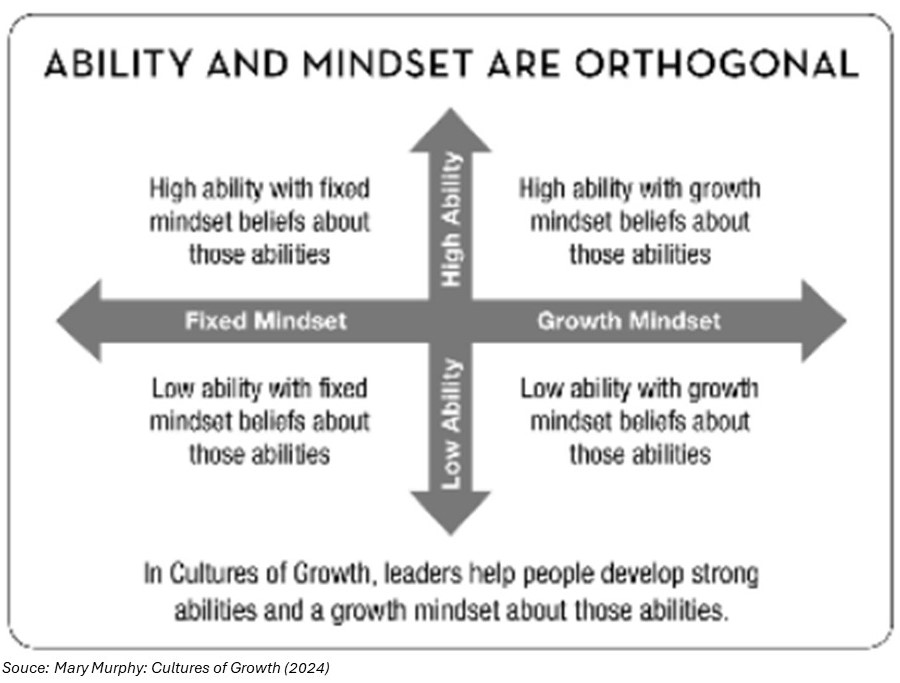Cultures of growth: the many benefits of growth mindset cultures
The mindset continuum
The author begins by dispelling the misconception that people can either have a growth mindset or a fixed mindset. She explains that mindset exists on a continuum. Where we are on this continuum can vary, and the environment we find ourselves in strongly influences our position. People don't have just one type of mindset; they can vary between a static and a growth mindset depending on the topic, the situation, and the influences from their environment.
Mindset cultures: from cultures of genius to cultures of growth
The environment, whether it is a family, a school, or an organization in which we find ourselves, strongly influences our mindset in that environment. The mindset of environments is also on a continuum. On one side are fixed mindset cultures (Cultures of Genius); on the other are growth mindset cultures (Cultures of Growth). In a culture of genius, people believe that human capabilities cannot or hardly be developed; in a culture of growth they believe that this is possible. Cultures of genius emphasize talents and results. Cultures of growth provide growth opportunities and emphasize motivation, learning, creativity, hard work, and process.
Mindset cultures influence values and behavior
Mindset cultures influence values within organizations according to a cyclical process that Murphy calls the organizational mindset-culture cycle. In recruitment and selection, candidates with the dominant mindset are sought. Candidates must exhibit this dominant mindset in order to have a chance of getting in. When working, we demonstrate behavior that fits the dominant mindset in order to have a chance at good reviews and promotion. Step by step, we internalize the properties that belong to the dominant mindset.
The mindset culture of an organization influences the following aspects:
1. Collaboration
2. Innovation and creativity
3. Risk taking and persistence
4. Integrity and ethical behavior
5. Diversity, Equity and Inclusion (DEI)
Mindset microcultures
Mindset microcultures refer to smaller subcultures within an organization that may differ from the organization's dominant mindset culture. They can thrive within a department, team, or group that cultivates a growth mindset, even when the rest of the organization may exhibit a culture of genius. These microcultures are important because they provide insight into how organizational culture change can occur and provide clues as to how the dominant culture can develop and change. These microcultures can reflect both the strengths and limitations of the broader organizational culture and provide valuable insights for change and development.
Mindset triggers
Mindset triggers are specific situations that tend to move people towards their growth or fixed mindset. These triggers are based on how individuals typically respond in certain interpersonal circumstances and can have a significant impact on their motivation, behavior, and performance. The four most common mindset triggers are:
- Evaluative Situations: Moments when people are judged or evaluated, which can motivate them to perform or become defensive.
- High Effort Situations: Situations that require extra attention and energy, such as quickly learning a new skill or adapting to change, can lead to a growth mindset or a fixed mindset.
- Critical Feedback: Receiving negative feedback can be threatening and affect one's perception of themselves as capable or incapable, which can lead to either avoiding criticism (fixed mindset) or using it as an opportunity to learn and improve (growth mindset).
- Success of Others: Observing the success of others can influence one's own behavior and motivation, either through inspiration and motivation (growth mindset) or through discouragement or jealousy (fixed mindset).
Understanding these triggers not only helps individuals understand and develop their own mindset, but it is also essential for organizations to understand how they can use this knowledge to support a culture of growth and continuous development. Organizations can identify these triggers and design interventions to encourage employees to activate their growth mindset more often, which can lead to more adaptive and resilient work behaviors and better performance.
Competence and mindset are independent of each other
Competence and mindset are two independent characteristics of people. Murphy describes this through the following two-dimensional model:
Murphy advocates that leaders within a culture of growth help people develop strong capabilities and a growth mindset about capabilities. This is in contrast to the strengths-based approach that suggests people should focus on what they are already good at, but which can actually lead to a fixed mindset and stagnation.
Mindset, interests, and gender stereotypes
Murphy also discusses the misconception that everyone is born with a passion and that discovering it is the key to success. This can be harmful because it can lead to the belief that if something doesn't come immediately, it's not worth pursuing, which in turn encourages a fixed mindset.
She also discusses a related misunderstanding involving gender stereotyping and its influence on areas of interest such as computer science. Young women and girls who have adopted a fixed mindset may not expect to be naturally attracted to or passionate about a field that is a good fit for them, contributing to the gender gap in STEM fields.
Mindset and feedback
Murphy discusses several other themes, such as how mindset influences thinking about feedback. In a static feedback environment, feedback, and certainly critical feedback, is a very charged subject. After all, feedback about what could be improved or what was not good can be interpreted as evidence of a lack of capabilities. In a growth mindset, people see feedback as normal and supportive of learning. In a fixed mindset culture, people will be inclined to focus feedback on results and personal characteristics. But in a growth mindset culture, feedback is very specific. It is about behavior, choices, and processes that can influence people. In addition, feedback can focus on effort and persistence.


Comments